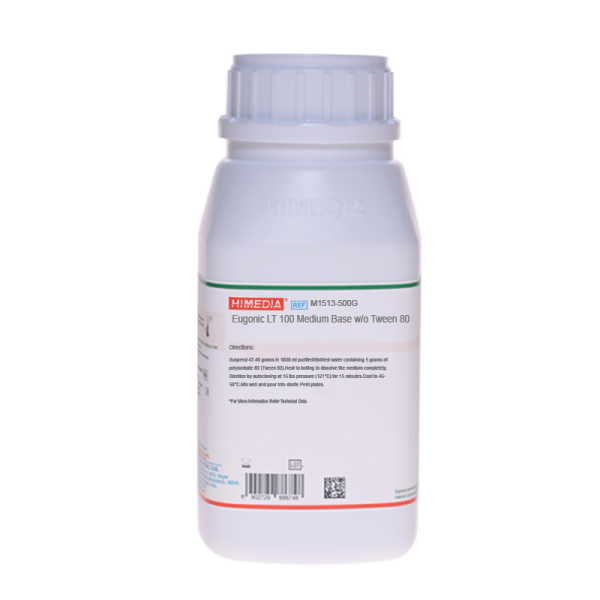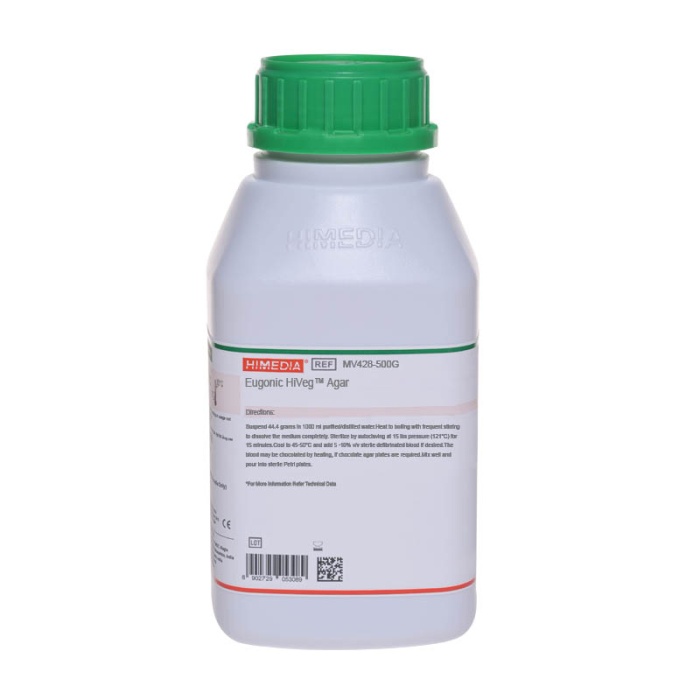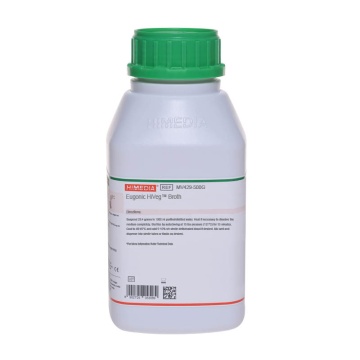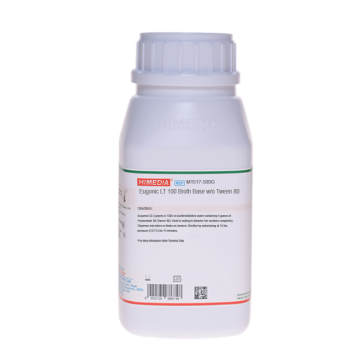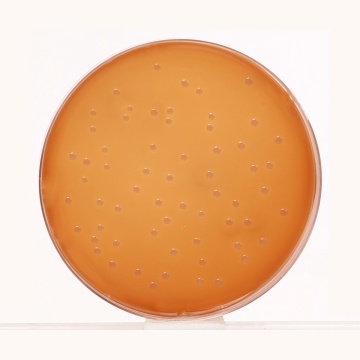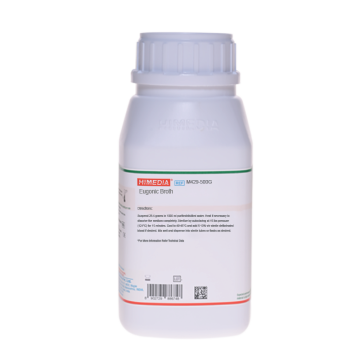 Your enquiry has been submitted
Your enquiry has been submitted
Eugonic LT 100 Medium Base w/o Tween 80
Francisella and Pasteurelle#CC293D
Intended Use
Recommended for cultivation of fastidious microorganisms like Haemophilus, Neisseria, Pasteurella, Brucella and Lactobacillus species.
Composition**
| Ingredients | g / L |
|---|---|
| Tryptone | 15.000 |
| Soya peptone | 5.000 |
| Dextrose (Glucose) | 5.500 |
| Sodium chloride | 4.000 |
| Sodium sulphite | 0.200 |
| L-Cystine | 0.700 |
| Egg lecithin | 1.000 |
| Triton X-100 | 1.000 |
| Agar | 15.000 |
Final pH ( at 25°C): 7.0±0.2
**Formula adjusted, standardized to suit performance parameters
Directions
Suspend 47.40 grams in 1000 ml purified/distilled water containing 5 grams of polysorbate 80 (Tween 80). Heat to boiling to dissolve the medium completely. Sterilize by autoclaving at 15 lbs pressure (121°C) for 15 minutes. Cool to 45-50°C. Mix well and pour into sterile Petri plates.
Principle And Interpretation
Eugonic LT 100 Medium Base was developed by Pelczar and Vera (1) for cultivation of fastidious organisms like Brucella. Eugon media were developed to obtain eugonic (luxuriant) growth of fastidious microorganisms like Brucella which are otherwise difficult to cultivate (2). The unenriched medium supports rapid growth of lactobacilli associated with cured meat products, dairy products and other foods. Eugonic media is quite similar to Tryptone Soya Agar (M290) but more bacterial propagation is expected on Eugonic media. Organisms like Bordetella and Neisseria form minute colonies on Tryptone Soya Agar (M290). They may become large on Eugon Media because large amount of sulfur and carbon sources have been added in addition to the Tryptone Soya Agar (M290) formula. Eugonic LT 100 Medium w/o Tween 80 can be used for growth of a variety of fastidious microorganisms like Neisseria, Francisella and Brucella.
Tryptone and soya peptone provide the nitrogen, vitamins and amino acids, which supports the growth of fastidious microbial species. The high concentration of glucose is the energy source for rapid growth of bacteria. L-Cystine and sodium sulphite are added to stimulate growth. Sodium chloride maintains the osmotic balance of the media. The high carbohydrate content along with high sulfur (cystine) content improves growth with chromogenicity (3). Lecithin and polysorbate 80 in Eugonic LT 100 Medium w/o Tween 80 neutralize antimicrobial agents hence this medium can be used as a neutralizing diluent.
Type of specimen
Food and dairy samples
Specimen Collection and Handling
For food and dairy samples, follow appropriate techniques for sample collection and processing as per guidelines (4,5,6). After use, contaminated materials must be sterilized by autoclaving before discarding.
Warning and Precautions
Read the label before opening the container. Wear protective gloves/protective clothing/eye protection/face protection. Follow good microbiological lab practices while handling specimens and culture. Standard precautions as per established guidelines should be followed while handling specimens. Safety guidelines may be referred in individual safety data sheets.
Limitations
- Further biochemical and serological tests must be carried out for complete identification.
Performance and Evaluation
Performance of the medium is expected when used as per the direction on the label within the expiry period when stored at recommended temperature.
Quality Control
Appearance: Cream to yellow homogeneous free flowing powder
Gelling: Firm, comparable with 1.5% Agar gel
Colour and Clarity of prepared medium: Yellow coloured, clear to slightly opalescent gel forms in Petri plates
Reaction: Reaction of 4.74% w/v aqueous solution at 25°C. pH : 7.0±0.2
pH: 6.80-7.20
Cultural Response: Cultural characteristics observed with added 5-10% sterile defibrinated blood after an incubation at 35-37°C for 48 hours (fungal cultures incubated at 25-30°C).
| Organism | Inoculum (CFU) | Growth | Recovery |
|---|---|---|---|
| Bacillus pumilus ATCC 14884 | 50-100 | good (with 0.1% starch) | 50-70% |
| Brucella abortus ATCC 4315 | 50-100 | good (under 3-5% CO2) | 50-70% |
| Candida albicans ATCC 26790 | 50-100 | good | 50-70% |
| Lactobacillus fermentum ATCC 9338 | 50-100 | good | 50-70% |
| Neisseria meningitidis ATCC 13090 | 50-100 | good | 50-70% |
| Streptococcus pneumoniae ATCC 6303 | 50-100 | good-luxuriant(under 3-5% CO2) | >=70% |
| Streptococcus pyogenes ATCC 19615 | 50-100 | good-luxuriant(under 3-5% CO2) | 50-70% |
| Staphylococcus aureus subsp. aureus ATCC 25923 (00034*) | 50-100 | good-luxuriant | >=70% |
| Staphylococcus aureus subsp. aureus ATCC 6538 (00032*) | 50-100 | good-luxuriant | >=70% |
| Candida albicans ATCC 10231 (00054*) | 50-100 | good | 50-70% |
| **Bacillus spizizenii ATCC 6633 (00003*) | 50-100 | good | 50-70% |
| ^Pseudomonas paraaeruginosa ATCC 9027 (00026*) | 50-100 | good | 50-70% |
| Escherichia coli ATCC 8739 (00012*) | 50-100 | good-luxuriant | 50-70% |
Key : (*) Corresponding WDCM numbers. ^ Formerly known as Pseudomonas aeruginosa **Formerly known as Bacillus subtilis subsp. spizizenii
Storage and Shelf Life
Store between 10-30°C in a tightly closed container and the prepared medium at 20-30°C. Use before expiry date on the label. On opening, product should be properly stored dry, after tightly capping the bottle in order to prevent lump formation due to the hygroscopic nature of the product. Improper storage of the product may lead to lump formation. Store in dry ventilated area protected from extremes of temperature and sources of ignition. Seal the container tightly after use. Product performance is best if used within stated expiry period.
Disposal
User must ensure safe disposal by autoclaving and/or incineration of used or unusable preparations of this product. Follow established laboratory procedures in disposing of infectious materials and material that comes into contact with sample must be decontaminated and disposed of in accordance with current laboratory techniques (7,8).
Reference
- Pelczar and Vera J., 1949, Milk Plant Monthly 38:30
- MacFaddin J. F., 1985, Media for Isolation-Cultivation-Identification-Maintenance of Medical Bacteria, Vol. 1, Williams & Wilkins, Baltimore, Md.
- Frank H. A., 1955, J. Bacteriol., 70:269.
- Salfinger Y., and Tortorello M.L., 2015, Compendium of Methods for the Microbiological Examination of Foods, 5th Ed., American Public Health Association, Washington, D.C.
- American Public Health Association, Standard Methods for the Examination of Dairy Products, 1978, 14th Ed., Washington D.C.
- Wehr H. M. and Frank J. H., 2004, Standard Methods for the Microbiological Examination of Dairy Products, 17th Ed.,APHA Inc., Washington, D.C.
- Isenberg, H.D. Clinical Microbiology Procedures Handbook 2nd Edition.
- Jorgensen, J.H., Pfaller, M.A., Carroll, K.C., Funke, G., Landry, M.L., Richter, S.S and Warnock., D.W. (2015) Manual of Clinical Microbiology, 11th Edition. Vol. 1.
| Product Name | Eugonic LT 100 Medium Base w/o Tween 80 |
|---|---|
| SKU | M1513 |
| Product Type | Regular |
| Physical Form | Powder |
| Origin | Animal |
| Packaging type | HDPE |
| References | 1. Pelczar and Vera J., 1949, Milk Plant Monthly 38:30 |
| Customized Product Available | No |



